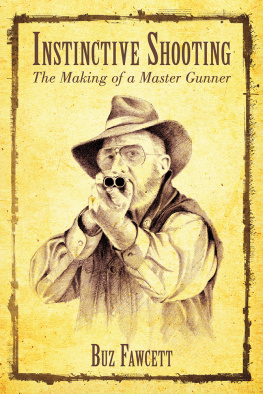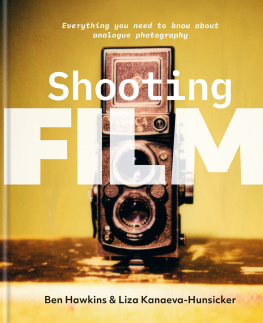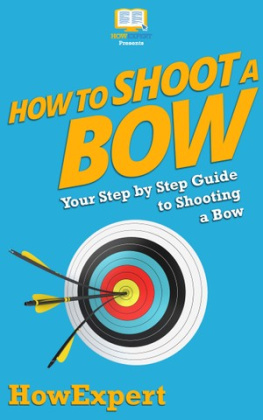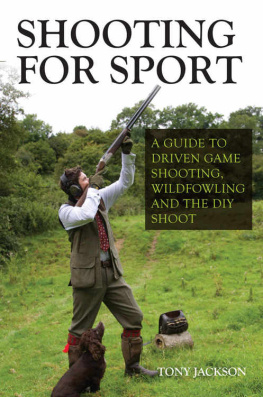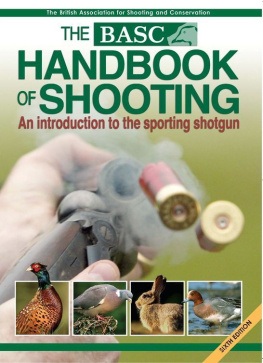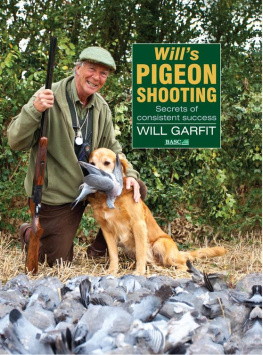INSTINCTIVE
SHOOTING
THE MAKING OF A MASTER GUNNER

BY BUZ FAWCETT
EDITED BY MARC C. PATOILE
ILLUSTRATED BY RUSSELL LAWS

Skyhorse Publishing
Copyright 2013 by Buz Fawcett
Illustrations copyright 2013 by Russell Laws
All Rights Reserved. No part of this book may be reproduced in any manner without the express written consent of the publisher, except in the case of brief excerpts in critical reviews or articles. All inquiries should be addressed to Skyhorse Publishing, 307 West 36th Street, 11th Floor, New York, NY 10018.
Skyhorse Publishing books may be purchased in bulk at special discounts for sales promotion, corporate gifts, fund-raising, or educational purposes. Special editions can also be created to specifications. For details, contact the Special Sales Department, Skyhorse Publishing, 307 West 36th Street, 11th Floor, New York, NY 10018 or info@skyhorsepublishing.com.
Skyhorse and Skyhorse Publishing are registered trademarks of Skyhorse
Publishing, Inc., a Delaware corporation.
Visit our website at www.skyhorsepublishing.com.
10 9 8 7 6 5 4 3 2 1
Library of Congress Cataloging-in-Publication Data is available on file.
ISBN: 978-1-62087-702-9
Printed in the United States of America
CONTENTS

INTRODUCTION

Take Heart. It Happened to Me, Too
When I was a kid, I was a great shot. Really! By the time I was fourteen or so, I had won a number of High Gun awards at local trap clubs. On Sundays, while other youngsters were receiving the benefits of catechism and the Gospel, I was learning the lore of the gun.
My dad was so proud that he awarded me my grandfathers Model 1912 Winchester. It was the same firearm that Captain Billy had used as captain of the 1924 Olympic trap team.
Captain Billy Fawcett was the Founder of Fawcett Publications, which published Whiz Bang, a racy pocket-sized publication designed to fit the pocket of a WWI doughboys tunic. The company went on to publish such notable magazines as True, The Mans Magazine and Mechanics Illustrated, to name but two of many.

My grandfathers singles trap gun was a lovely Winchester Model 1912. It originally was a field gun, but over the years it had gradually been transformed into a trap model.
That Model 12 was, and still is, a lovely firearm. It had been manufactured in 1919 and tastefully engraved, apparently as a field gun. Later, its 30-inch barrel had been crowned by a Simmons ventilated rib. In deference to my size, Captain Billys stock had been removed by my father and a truncated Model 12 stock was installed. In spite of the fact that it kicked the whey out of me every time I used it, I shot it successfully until my shooting was visited by what I called the Dark Ages. My brilliance with a shotgun didnt last.
In the beginning, Dad had told me, Here, point this at the target and pull the trigger. In those earliest of days, I was using a sort of single shot 16-gauge, similar to those that every well-meaning father gives to an offspring in the hopes that, by some miracle, the youngster will overcome the deficiencies of design that the father had struggled with when his father gave him a gun just like it. I couldnt overcome it, and the results were predictable.
In an attempt to change those results, Dad dug around in his gun cabinet and came up with a lovely .410 Ithaca side-by-side. We went forth with some sort of a little ground trap and tiny targets called mosquitoes. He repeated his famous instructions, Here, point and shoot. Since I believed everything he told me, I did as instructed and, before long, the little targets were exploding with satisfying regularity. I simply pointed at the target and pulled the trigger.
When I graduated to trap, I again inherited Captain Billys Model 12. It didnt fit me very well. But, my God, how that gun kicked. It took me til Thursday or Friday each week, before the bruising achieved an ugly yellow-green, which I came to consider as preparation for Sundays weekly beating.
Years later, I look back with wonderment at the vicious pounding I gladly took. Especially in light of my recent discovery that Captain Billys Model 12 had a 2 9/16-inch chamber. Oh, I know, all Model 12, 12-gauges are supposed to have 2 3/4-inch chambers (easily verified by The Winchester Model Twelve by George Madis), but this one, made in 1919, had the shorter chambers to accommodate the old, roll-crimp shells.
Gradually, I overcame some of the weekly bruising by padding both myself and the gun. At the time, I figured looking like the victim of child abuse was simply the price one paid to achieve championship caliber.
I havent shot that gun in decades. Self-inflicted pain isnt one of my vices. But recently, I took it in to have it refurbished as a family heirloom.
Did you know this has a short chamber? the gunsmith asked. My jaw fell open.
Youre kidding!
Nope, look it here. Hed removed the barrel and dropped a chamber gauge into it. Musta kicked like hell, he observed.
Musta indeed. Instead of the nominal eight to ten thousand pounds of chamber pressure, I was being whacked by a hell of a lot more than that. But the relative abuse the gun rendered had little to do with the evil times of the Dark Ages that had begun to dawn on me.
The Dark Ages began when my dream of a lifetime was realized. I was hired as associate editor of Sports Afield magazine in New York. The rare benefit of this position was that I was invited for shooting at various get-togethers held by manufacturers for members of the outdoor media. Unfortunately, at the same time, I was fulfilling the duties of an associate editorediting, lots of editing. And the Dark Ages crept into my life like fungus invading a host.
You see, the problem with editing is this: you are also required to read all of the copy that you are editing. Sure, every now and then an article about shooting shotguns would crop up. Unfortunately, few of them bore any resemblance to my fathers sage instructions of, Just point and shoot. And, so I read. And, little by little, the garbage that those writers were touting seeped in. Sustained Lead was very popular back then. Shortly, it was followed by Swing Through and its henchman, Pull Away. My final fall from grace into the Dark Ages came when I saw an infamous chart published by someone on leads. You probably remember it too. It has a series of ducks flying, together with a calculation of the exact amount of lead necessary to hit them when they are flying at so many miles per hour. I realized immediately that trying to calculate which technique to use on what kind of target, flying at some speed or another, made successfully shooting a shotgun damned near impossible. And, my shooting began to suffera lot.
Luckily, there was one event that helped to bring my shooting career out of the Dark Ages. I met Ad Topperwein. Ad was a legendary demonstration shooter (or what we used to call a trick shot). I met Ad at a function for outdoor writers and was amazed at his ability with a firearm. This led me to Herb Parsons, who was another demonstration shooter for Winchester. Luckily, Herb had made a motion picture that featured his son, twelve-year-old Fred. Herbs motion picture simply tantalized me. Herb was a Tennessean who shot for Winchester for many years, and he was just not doing what the sage tomes were hyping in the pages of

